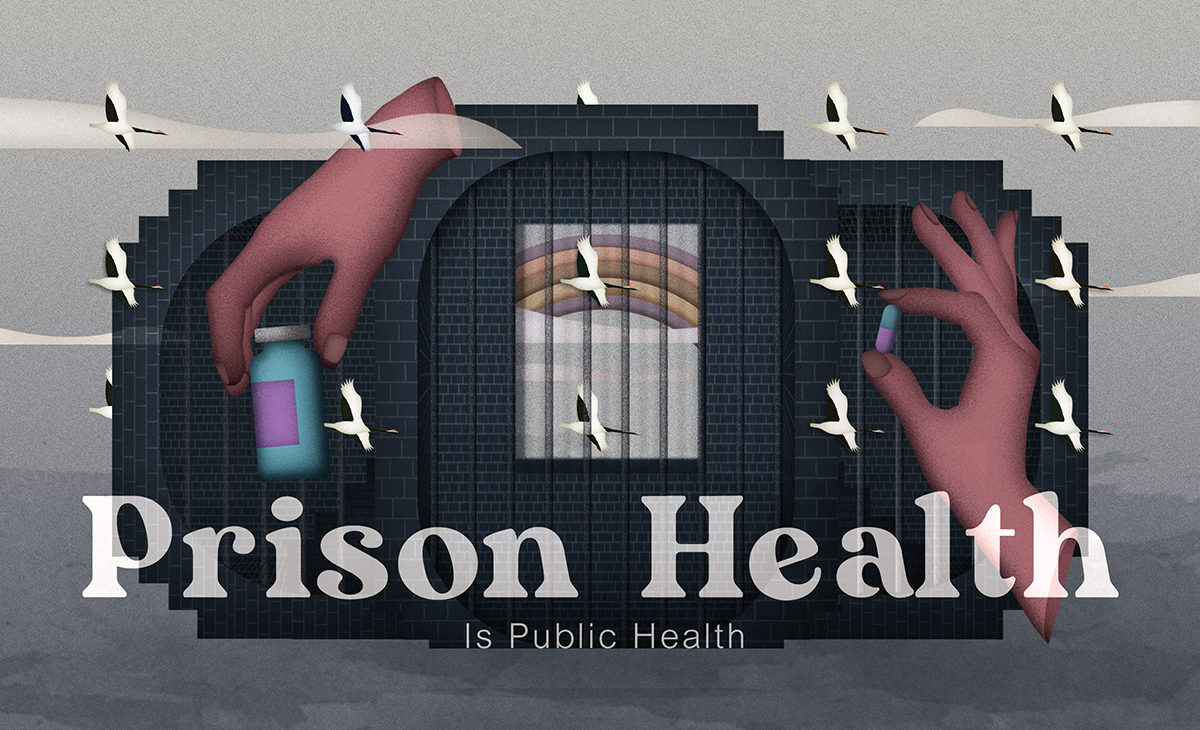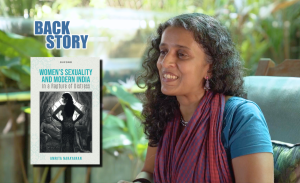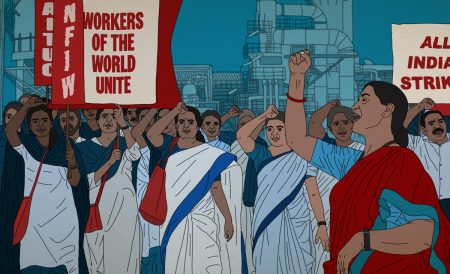Anubhab Atreya is a lawyer by training and one of the founding members of Studio Nilima, an Assam-based research collective that works in the areas of law, conflict and governance, especially in northeast India. Through his work in correctional homes, he facilitates legal services and strategic litigation apart from researching policy. Here he talks to The Third Eye about a major area of policy concern – equitable access to healthcare within prisons.
How does your work at Studio Nilima connect to public health?
One of the things we do at Studio Nilima is look at correctional homes* from a systems perspective. When we reflect on the work that we have done since 2017 on human rights or the legal services mechanism, we find that a lot of those questions were also public health questions. Every time we visited a client and dealt with a situation, there was always an underlying public health issue.
I remember the first time I saw a jail hospital. Even for people with legal backgrounds like me, a correctional home is a closed space. Even if you interact with a client, you don’t usually get exposed to the system as a whole. On paper, that jail had seemed like it had a proper hospital with facilities that could admit up to 100 people. You go in and you realise that it is just one room with a table and a chair. And probably a pharmacist who doesn’t live on campus so he wouldn’t be available at night.
Here is another incident I remember very vividly. We met an 80-year-old inmate at a correctional home. When we went the next week, we found out that he had died. He had suffered a cardiac arrest at night and there was only one ambulance in correctional home and it didn’t work. These incidents really made an impression on all of us, and we realised there is a huge scope for policy interventions.
*In many parts of the world, including several Indian states, the term jail has been replaced by correctional home to reflect a change in objectives from punishment to reform.
Why are the conditions of people in prisons a public health issue?
For a person who’s not exposed to the justice system, it’s very difficult to gauge why correctional homes are important as a governance issue.
It's something that the discourse always leaves out but correctional health is also public health. That’s because a correctional home is essentially a microcosm of the society that we have.
First, we need to understand that a prison does not exist in isolation. It is interacting with society on a day-to-day basis. People are getting released from correctional homes, people are going into correctional homes. It’s a revolving door.
Second, there are the moral and ethical issues of incarceration and vulnerable populations. When vulnerable populations outside the correctional home go into the correctional home, women [4.2% of prison inmates, according to the National Crime Records Bureau] and children for example, are at a double disadvantage.
We have found in our research that every [instance of] discrimination you face outside the home gets magnified inside.
According to the National Crime Records Bureau (NCRB) data, as of 2019, of the 4,78,600 prison inmates in India, nearly 66% belong to the Scheduled Castes, Scheduled Tribes and the Other Backward Class categories. The journalist Sukanya Shanta has reported in detail on how caste dictates what labour you perform inside prisons. These are the factors you are talk about, right?
Yes, the intersectional multiple discrimination that we find in our social structures is reflected inside correctional homes too. The disparities as regards gender are also quite visible inside correctional homes. One prime example, which Studio Nilima has written about, is the architecture of correctional homes. The women’s wards are often closed-off areas within the correctional homes. This creates barriers for access to common facilities like the library, open community spaces, etc. This also impacts their access to gender-specific healthcare needs such as female medical and paramedical staff or gynaecologists. Again, the lack of women among the correctional staff, especially among the officers too creates a situation where women face discrimination; first as inmates and second, as a marginalised section within the inmate population.
We need to ensure that correctional homes are independent in terms of healthcare services.
The structure we have now, at least in Assam, is that the correctional home is completely dependent on what we have outside, the district hospital or the tertiary medical college in the area. Covid has taught us that when the external healthcare system gets overburdened, you’re left isolated with no facilities inside the correctional home. Infectious diseases really multiply in the correctional home. If we don’t ensure they’re contained, it becomes a public health hazard and a human rights violation. There are many, many arguments for why correctional health should be part of public health.
The over-dependence on setting up tertiary care or speciality hospitals and not enough primary care that we see all over India, is that true for prisons as well?
Yes, that’s true. Whenever there’s a tertiary centre in the vicinity, institutions imagine that we can depend on it instead of focusing on the fundamentals.
What happens then in the case of disease control – forget pandemics – in the case of an epidemic?
The Supreme Court has directed that all correctional homes across the country should adopt the Model Prison Manual 2016. Unfortunately, that hadn’t been adopted by Assam till just a few months ago. The government issued a statement saying that they adopted it. We haven’t seen the notification yet. What we had then was the Assam jail Manual, which is from the 19th Century. There are specific provisions in it for epidemics but of course, they are dated. They were drafted with the primary concern of security and so they are quite draconian at times. As of now, the regime is really dependent on a medical officer who’s supposed to be in the correctional home and it is his job to ensure quarantines or refer people to hospital.
Thankfully, the Model Prison Manual 2016 is more advanced and many states have adopted it. Some have been slow.
What are the implications of adopting the Model Prison Manual (MPM) for public health?
The MPM is very idealistic in what it sets out to do. For example, it says that for every 100 inmates, the jail hospital should have 50 beds available at any point in time. It is idealistic but it gives a standard for the department to work towards and achieve a modern standard of living.
And secondly, once you adopt it, it gets a statutory character. The manual is always available for people to enforce it in a court of law. At least once it is a standard, I think, then it’s up to civil society also to enforce it. So it’s very important.
What are the current standards? In one of your papers you say you got replies from 22 correctional homes in Assam through an RTI [application], of which 14 correctional homes had regular visits from a doctor, for instance. You have this kind of data about Assam. Can you paint a picture for us nationally about what is the state of healthcare for prisoners?
Nationally, there are wide variations as healthcare is dependent on the statutes each state has (if they have not adopted the Model Prison Manual). Certain states like Telangana have been very proactive in ensuring high standards for healthcare and all other facilities. With Assam now, or at least the situation before the Model Prison Manual, was that there are very few permanent doctors at correctional homes. Usually they have ad hoc doctors from the nearest government hospital who’d visit for a couple of hours a day, a few times a week. That’s just not enough if you have 300 people in a closed environment.
The mandate is that you have someone in-house who stays in the correctional home. You also have a nurse, you have a gynaecologist available. That just never happens. Mostly you have a pharmacist in correctional homes. Some of them only have first aid facilities. They are very dependent on the nearest hospital. And that is very difficult because every time you need to take a patient out of the correctional home, there's a whole security process that you have to follow.
You have to call the SP of the district. Then arrange for police escort. Only then can the patient leave.
Isn’t that last detail a massive hurdle? This reinforces what you were saying that prisons need to have their own setup.
Yes, exactly.
What kind of thinking does the Model Prison Manual reflect?
It had a huge drafting committee of people from various backgrounds — administrators who have run correctional homes, academics, people with a legal background, people from civil society. It is aspirational, which is something that we need. There are definitely gaps in many cases but it addresses many issues – like looking at correctional institutions from a gender lens or the issues of juveniles.
When you look at the history of public health in correctional institutions over the last few decades, what changes have you observed?
In 2013, the Social Justice bench of the Supreme Court took up a suo motu petition, ‘Inhuman conditions in 1382 prisons,’ prompted by a letter written to the Supreme Court by Justice R.C. Lahoti, a retired Chief Justice. The SC pulled up all the state governments and asked them what they were doing about prison reforms. When it realised that there were no uniform standards, the SC asked the Bureau of Police Research and Development to get together a committee which then drafted the Model Prison Manual. That was a really important turning point.
You said it became much clearer in the pandemic that you need to have independent medical facilities. Have there been other such insights that have sharpened because of the pandemic?
Yes, a few. One, the question of vulnerable populations being doubly exposed to any epidemic or pandemic – beginning with geriatric prisoners, who are often people with comorbidities.
If you are a person with comorbidity inside the correctional home, unlike a citizen outside, you don’t get the option of even choosing a hospital.
Two, all the policies around correctional homes, the first priority is security. Which means that staff and officers were also required to be exposed to the infectious environment to ensure the administration of basic protocols such as social distancing, and hand washing. Third, the issue of administrative inertia. When vaccination or testing started back in the first wave, there was not much movement for correctional homes until the Guwahati High Court got involved. Four, nutrition is not up to even moderate standards. Good nutrition is essential for protection from infectious diseases. Good nutrition acts as a prophylactic.
Ah, yes. Now, what is the big picture to improve public health of people in correctional homes?
Early on in our work, we were talking to some inmates. They said that they had no access to sanitary napkins for a month. We found that there were stocks of sanitary napkins but they had not been sent out because a file got held up somewhere. What happens when you are dealing with the issue as an administrator is you are just thinking of it as a file or a procedure. You’re not thinking about what that file concerns – something essential to a person down the line.
The Model Prison Manual is quite different but a lot of the legislation right now is drafted top-down. They are not informed by the experiences of the inmate or the staff. The first priority for any policy should be that you listen to people who are the ultimate beneficiaries of whatever you’re making.
People higher up in the hierarchy need to develop empathy for people who are in the correctional home, and to understand their problems and to let them speak instead of just implementing policy.
Because, more often than not, you'll find people with personal empathy within the system. They want to do well. But ultimately, they are limited by the statutes and bureaucracy. So, it’s very important to cultivate institutional empathy – that institutions can empathise…
Secondly, I think it is important to deal with administrative inertia because it’s very difficult to get things done, even when there is a human rights violation. There are many design issues. For example, someone sitting at headquarter decides which correctional home gets how much money for medicines for that quarter. It’s not up to the superintendent.
In your paper, you very politely say we don’t know the cause for administrative inertia, we need to research it more.
[Laughs} There really are some huge issues. For example, in Assam, the jail department itself is not a department; it’s a directorate within the home department. What that means is that they don’t have autonomy as regards funds. They have to constantly coordinate with the home department – which is very busy with other things – to ensure that they get funds on time, or that they can do reforms.
On the other hand, in states that are doing really well with prison reforms, Telangana, for example, the jail department is an independent department. That really eases things when it comes to administrative reforms and finances. Also, these departments are not interdisciplinary in nature. Nor do they speak with each other.
The jail department needs to interact with the health department on a daily basis. A lot of problems can just be solved with normal dialogue.
But because they’re communicating on paper and there’s the bureaucracy… it contributes to administrative inertia which trickles down to the correctional homes. The people in the homes send requisition after requisition and don’t get an answer. It’s also a lot of pent-up frustration. There’s a lot of frustration with service conditions. If you see staff quarters you may feel that the situation inside the correctional homes are better.
Of course, there is a small percentage of people who are not so well-meaning. Most people are frustrated and were well-meaning once.
You have mentioned Telangana twice. Could you talk a little more about the reforms there?
Telangana is widely seen as an example because there’s a lot of civil society engagement. They’ve done really well in research and training. The Institute of correctional Administration there is quite prestigious, and well known for training officers. They’ve also done a lot of revolutionary work in aftercare.
Aftercare disrupts that vicious circle of incarceration. Because once you help someone who has served their sentence come back into society and they are better off than when they came in… that's really the ideal of any correctional system.
Something that’s really lacking in most correctional systems. In Assam, I think, aftercare is limited to giving vocational education in some cases, or a one-time monetary support when you get released. We also have an open jail in Jorhat that remains underutilised.
I must add that it is hard to extrapolate learnings in correctional homes unless you have field experience of yourself understanding that system. A correctional home is a highly localised experience. It is very difficult to detect patterns for us even across Assam.
That’s very interesting.
Yes, for example, anyone who visits correctional homes on a regular basis will tell you with conviction that each has a distinct atmosphere. In Mori Gaon district jail in Assam, you will find an almost village-like, communal atmosphere. As soon as you enter there’s a large courtyard, and then there’re Assam-style houses all around. And then you contrast that with Guwahati Central Jail, for example, which is a huge, grey building – you know it’s a place of incarceration as soon as you see it. Couple that with the stakeholders, the particular superintendent or the jailor, the inmates who have stayed in that correctional home for 12 or 13 years and know the place better than the officers. So whenever we try to look for patterns we are cognisant that there are distinct differences. When we take learnings from other states, we have that caveat.
Someone else we interviewed said that in India, we believe that we are on our own as far as health is concerned. That we don’t even really expect the government to do anything for us. What does constitutional law guarantee us in terms of health?
To answer that question, I will come back to the correctional home perspective because it drives this point home much better. When you get incarcerated, you first lose your right to personal liberty under Article 21. You lose your right to freedom of movement under Article 19, and you also lose your right to vote, which is a statutory right. But what you don’t lose? Your right to the highest attainable standards of health, which is now part of Article 21 in this constitutional framework. Also the International Covenant on Economic, Social and Cultural Rights (ICESCR) introduced the concept of the highest attainable forms of physical, mental and social well-being.
Now, it's been clarified by the Supreme Court, that the right to health is part of Article 21. That it is inalienable, and that's available to you whether you are in the correctional home or outside.
The low expectation of healthcare from the government is magnified inside the correctional homes.





